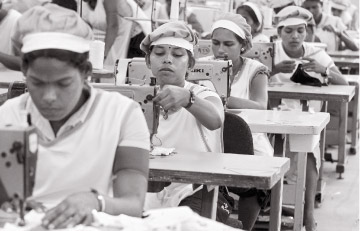The path to economic recovery
Sunil KARUNANAYAKE
Balance of payment difficulties are not uncommon to most developing
nations as they are constantly plagued by issues such as internal
conflicts, poverty support, welfare schemes, debt repayments, investor
withdrawals etc and huge import bills due to limitation of domestic
resources.
In the mid 1970's following the formation of the OPEC cartel and the
steep increase in prices of petroleum products then government faced a
severe foreign exchange crisis that was further compounded by declining
export earnings in the aftermath of the land reform.
|

Garment and apparel industry, major contributor to economy |
Limitation of foreign exchange obviously leads to shortage of
imported essentials thus leading to shortages. In fact foreign exchange
releases for overseas travel, education, health were drastically
restricted. During this era car imports were totally banned.
Economic resurgence
However following the economic liberalization in 1977 some far
reaching reforms in exchange rate unification, import liberalization,
export incentives, further liberalization in shipping, banking etc
resulted in an economic resurgence. Even during this regime then
government had to face a massive hike in oil prices and one of the
counter measures adopted was a total ban on cars on Sunday afternoons.
The global financial crisis of 2008 that brought the global economy
to standstill adversely affected the economic fundamentals in the midst
of a raging war in the North and East in Sri Lanka. However due to
limited exposure and capital account restrictions limited further
damage. Export economy suffered a major setback due to the economic
crisis crippling most of our export markets thus drastically limiting
foreign exchange earnings much needed to boost reserves.
The Sri Lankan economy, its setbacks and IMF assistance has been a
much talked about topic in the country. However it was not all gloom as
the prophets advocated but a positive forecast for a nation poised for
economic recovery and massive development programmes taking place after
nearly three decades.
Global financial crisis
IMF SBA facility initially was provided to Sri Lanka in 2009 amid the
global financial crisis when the county's reserves hit a low level.
IMF representative, borrowing from the titles of Churchill's famous
multivolume history of World War Two - described a ‘Gathering Storm,’
that is, the build up to the economic difficulties that peaked in early
2009.
He highlighted the rising oil price widening the trade deficit,
remittances, a significant source of external financing declining, loss
of global investor appetite, making inroads into a deteriorating
economy, and continued large fiscal deficits which were financed
increasingly from external sources causing further issues when the
global crisis brought despair. CBSL’s approach in defending the rupee by
selling dollars at the expense of reserves was seen as ‘Triumph and
Tragedy,’ in that the rupee was kept from falling far too quickly, but
at the cost of much needed dollars; that was not sustainable.
Foreign reserves
Well what we are witnessing at present is somewhat of a replay of the
2009 scenario. It must be noted that during 2009 period Sri Lanka was in
the last stages of the war with intense fighting in the battlefields.
Rigidity of the exchange rate and the cheap credit perhaps facilitated
imports thus expanding the trade deficit.
After much deliberations IMF on April 9 approved $ 427 million loan
to Sri Lanka hoping to swell the government coffers that have been
adversely affected by a threatening trade deficit. IMF noting the
economic recovery of 2011 commented on the easy access to credit.
Rigidity of the exchange rate has been instrumental in a massive trade
deficit that's said to be around US $ 10 billion equivalent to 20
percent of the country’s GDP.
They also added that country’s foreign reserves have been decimated
leaving the economy exposed to external shocks. Sri Lankan government
rose to the occasion and took immediate steps, such as the following;
* To provide exchange rate flexibility three percent evaluation was
implemented in November 2011
* Given the unmanageable credit growth, leading credit expansion and
related consumption policy rates were revised after considerable time
* Domestic prices of petroleum and electricity were increased to
arrest the increasing debts of state owned energy producers
* These measures were followed by massive import duty increase in
motor vehicles, trishaws (popular mode of public transport) etc to boost
the government revenue, as well as, to curtail foreign exchange. It
should also be noted that country's road network is already under heavy
pressure due to increase in vehicular traffic in addition to high
frequency of fatal accidents.
Economic researchers feel that the pain of relief measures will be
felt for around 12 to 18 months and thereafter stability could be
established. IMF too has expressed satisfaction on government
initiatives in the recovery process.
Export sector
As an island economy Sri Lanka has limited options, hence, providing
assistance to export sector is critical in building up foreign exchange
reserves. Agricultural exports like tea and cinnamon needs to be given
every assistance as their potential is not fully utilized.
Tea sector has been severely affected by inclement weather,
exorbitant wage increases and land limitations. Problems are more acute
in the high growns where labour lives in the plantations. Recently
government set up a fund to support brand promotion for tea to encourage
brand marketing as against supplying unbranded to the global market.
Garment and apparel have been steady and remain as the largest export
earners.
It is also heartening to note that the recent Export Development
Board sponsored export promotion event in Colombo has been a huge
success. This augurs well for the much planned USD 20 m export earnings
target.
After having gone through an import surge of motor vehicles it seems
sensible that the recent import duty hike will curtail the burden on the
roads as well as the increasing fuel costs. |



